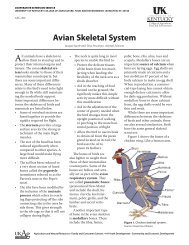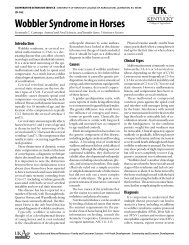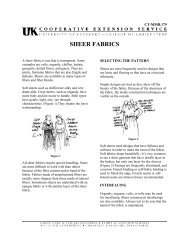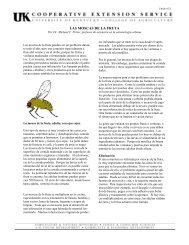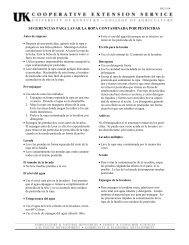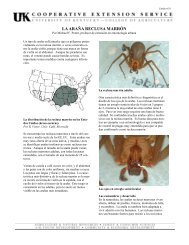Chapter 3 - CHICKEN ANATOMY AND PHYSIOLOGY
Chapter 3 - CHICKEN ANATOMY AND PHYSIOLOGY
Chapter 3 - CHICKEN ANATOMY AND PHYSIOLOGY
You also want an ePaper? Increase the reach of your titles
YUMPU automatically turns print PDFs into web optimized ePapers that Google loves.
of course, it will not contain an embryo and will not hatch. Simply put, "Hatchability can<br />
never be better than fertility."<br />
Fertility is affected by both the male and the female, and both tend to decline as the<br />
chickens age. Flock fertility is dependent on the reproductive status of the chickens (i.e.,<br />
level of egg and semen production) combined with the chickens’ interest and capability<br />
of mating. The fertility of a broiler breeder flock usually increases from a low of 65-75%<br />
at the start of lay (23-24 weeks of age) and peaks at 95-98% at 35-37 weeks of age.<br />
Between 40-45 weeks of age fertility declines and the older the birds get the faster the<br />
decline in fertility. From the female side, the decline in fertility is believed to be due to<br />
faster release of sperm from the sperm storage tubules. As a result, after 40 weeks of<br />
age the breeder hen needs more frequent mating to sustain high fertility. From the male<br />
side it is presumed that there is a decrease in sperm quality as the rooster ages, as well<br />
as a decrease in mating activity. There is also believed to be an increase in early embryo<br />
death in the second half of the reproduction cycle. These early deaths often appear as<br />
‘clears’ and may be mistaken for infertiles.<br />
Walking through the supermarket, it is often possible to find capons for sale. While it is<br />
obvious from the shape of the packaging that it is a bird of some kind, there is often no<br />
indication in the labeling of what exactly a capon is. An informal survey of 4-Hers with<br />
poultry projects and university students very few knew what a capon is. In caponization,<br />
the surgical castration of male chickens, the testes of the male chicken are completely<br />
removed. As a result, the cockerel fails to develop certain male characteristics or tends<br />
to lose them if they are developed. Capons are usually quiet and docile, lacking a<br />
cockerel's disposition to fight. The comb and wattles cease growing after castration, so<br />
the head of a capon looks small. The hackle, tail and saddle feathers grow unusually<br />
long.<br />
Removal of the testes, and thus elimination of the male sex hormones they produce,<br />
reduces the male sex instinct and changes their behavior. They will become more docile<br />
and less active. Energy that is normally expended in fighting, courting behavior, and<br />
territorial protection is greatly reduced, allowing more efficient conversion of feed into<br />
growth, fat deposition and improved meat quality.<br />
Caponizing produces a unique type of poultry meat grown for a specialized market. The<br />
meat of uncastrated cockerels tends to become rather coarse, stringy, and tough as the<br />
chickens age. This is not the case with the capon. Caponized males grow more slowly<br />
than normal male chickens and accumulate more body fat. The concentration of fat in<br />
both the light and dark meat of capons is greater than that of intact males. It is claimed<br />
that the capon meat is more tender, juicier, and more flavorful than regular chicken.<br />
Any breed of chicken can be caponized. Over the past 100 years breeds that were<br />
particularly favored for capon production included Jersey Giants, Brahmas, Orpingtons,<br />
Cornish, Plymouth Rocks, and Cochins. Today commercially grown capons are<br />
produced using the Cornish x Plymouth Rock cross typically used by the commercial<br />
broiler industry. Male birds are typically caponized at two to four weeks of age. The<br />
testes of a male chicken are located within the abdominal cavity. A good caponizer can<br />
operate on about 200 birds per hour. Commercially grown capons are marketed at 15 to<br />
3.18



